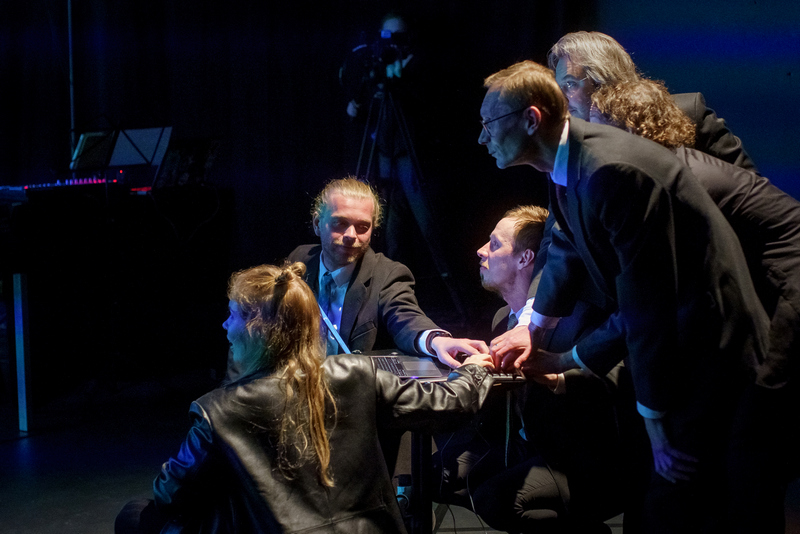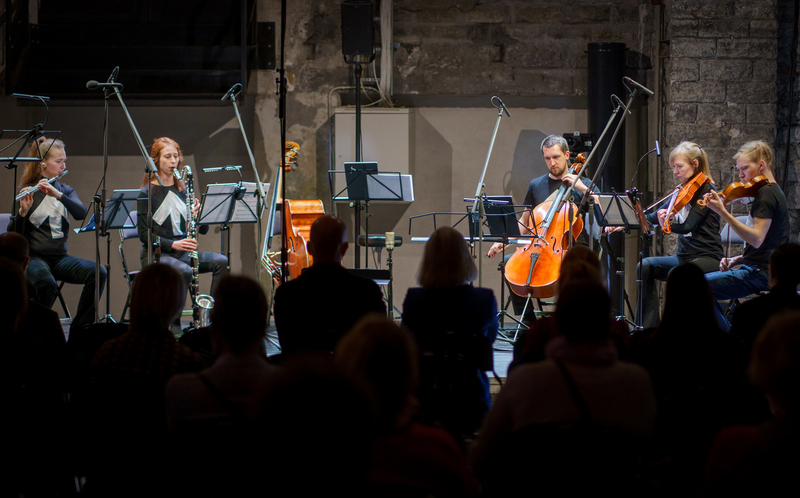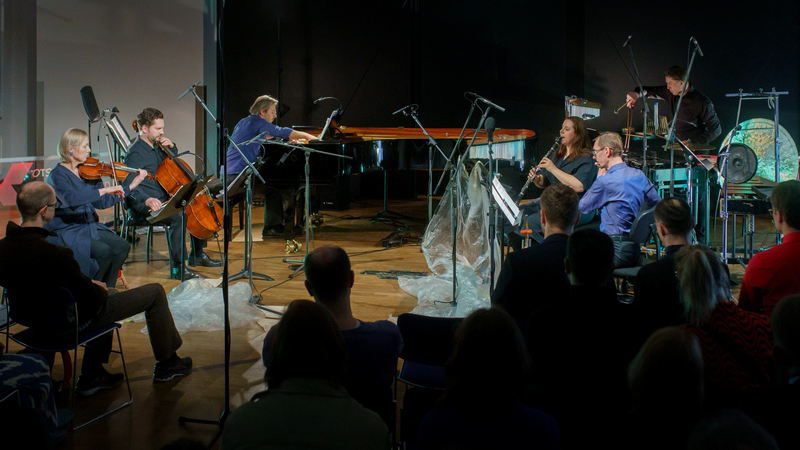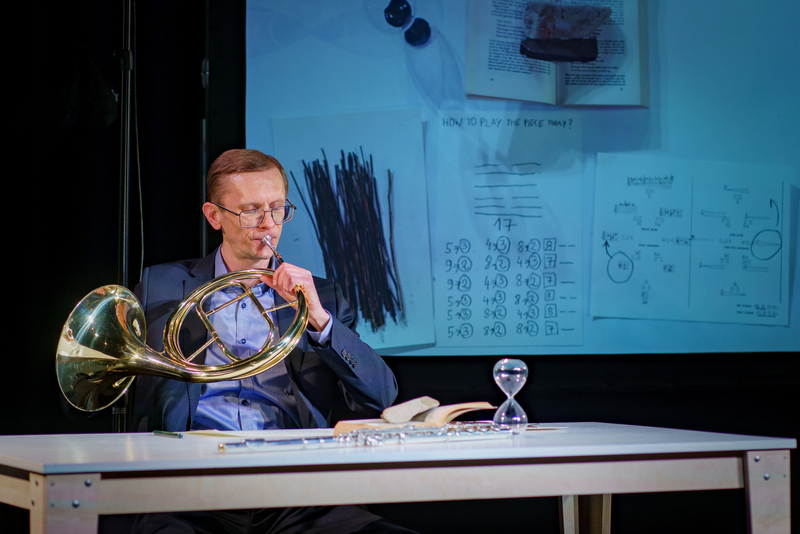
Surely the most completely abstract music i heard at this year’s Estonian Music Days was Blue Moon Station by Latvian composer Alise Rancāne. The piece involved all six members of the Ensemble of the Estonian Electronic Music Society (EMA) huddled around a computer keyboard playing a video game projected on the wall, trying to win points through a series of levels. What exactly were the rules of the game? Could the sounds generated by playing the game be called ‘music’? To be honest, I don’t know the answer to either of those questions but I’m not sure it matters: the performers’ actions created sound – beyond that, perhaps it’s up to us to decide what to make of it.

At the same concert, Malle Maltis‘ Variations on White explored the notion of white noise, forming it into playful bursts and rhythms. In practice, very little (if any) actual white noise seemed to be used in the piece, as it was either filtered in various ways or attenuated into pitch, later featuring the addition of sine tones and blips (bringing to mind the work of Ryoji Ikeda). This was followed by Ekke Västrik’s Contrasts, another abstract piece comprising a fascinating improvisational stream of consciousness channelled into a sustained, messy pitch chorus. It was exciting and lovely in equal measure, passing through a muscular throb before ending in soft shimmering. In Phantom Trails by Sander Saarmets, a prologue of haphazard bleeps fired by the players at each other was followed by a powerful noise-fuelled texture, as if those languorous opening noises had been channelled into viscerally fierce and fearsome sound formations.
It was Saarmets who created some of the most potent abstract music that i heard at this year’s festival, nowhere more so than in his new work and the sky turned yellow, premièred by Ensemble New Music Tallinn in the Kultuurikatel on the opening night. Inspired by a surreal dream, Saarmets’ material formed an elusive, tense texturescape, where the focus seemed to be less about any particular sound or idea than the total electroacoustic effect. There was a distinct sense of pent-up power, even fury, lurking within; at the time i wished Saarmets would allow it to let rip, but his directing of this power into something more reflective was arguably more effective and nicely went against such expectations. It was a highly effective harnessing of abstract ideas, providing hints of something tangible to keep us connected to its fascinatingly strange language.

As in so much of his previous work, Iranian composer Arash Yazdani appeared to be striving again for a similar focus on abstraction – sound as phenomenon – but everything about his compositions Stromateis and WinterWolf seemed like little more than basic student sketches or experiments, rather than fully-formed mature compositions. As such, in both cases their durations felt self-indulgently overlong, hardly warranted by the music’s paucity of invention. Another disappointment came from the usually reliable Evelin Seppar, whose new clarinet concerto Kraft, as its name suggests, took the simple idea of power as inspiration, together with a small amount of J. S. Bach. Performed by the Estonian National Symphony Orchestra with soloist Soo-Young Lee, it was a genuinely surprise to hear the spectre of postminimalism – surely the most relentlessly slave-driven genre in all music – being resurrected and reheated in nothern Europe. (It made me realise, with some relief, how long it’s been since i last encountered it in a concert hall.) There was some interest to be found at the start of its fourth movement, where the piece entered a place of vague mystery, but for the most part the music consisted of predictable episodes of rhythmic pulsing and repeating that have become so familiar that we hear them literally everywhere. There were times when it was like listening to a TV advert for a bank. Considering how imaginative Seppar can be, it was bizarre to hear her using such a generic, unoriginal mode of expression.
It was good to hear a live performance of Age Veeroos‘ Vaatenurk [Point of view], a piece that i’d hitherto only experienced online, as part of a project by Ensemble U: exploring the possibilities of giving interactive control to the listener to alter the nature and parameters of a performance in real time. As a fixed composition, it seemed to be providing each performer an opportunity to express themselves (their point of view, perhaps), in a sequence of solos passing from one to the next. A concentrated catalogue of ideas that came together partway through in a tutti, it was unclear to what extent an overall agreement or concensus had been reached. As with its online version, it’s a piece that would benefit from further listenings.

At the same concert, Tatjana Kozlova-Johannes‘ Corners presented an exercise in abstract disorientation. Progressing through wild accents, gentle repetitions, scrunchy plastic noise, an engagingly weird series of electric guitar glissandi, and some unsettlingly blank passages, the work’s fundamental volatility – as if following a zig-zag narrative that consisted only of corners, with barely any chance to go straight ahead – only made it more intriguing, all the more so when it hinted at a dark, possibly painful, inward lyricism at its end. Where were we? How did we get here? It added an unexpectedly emotive aspect to what was otherwise something of a cool, calculated, labyrinthine puzzle.
Abstract ideas found their most marvellously leftfield expression in a concert at the Fotografiska gallery given by flautist Tarmo Johannes. Did I say flautist? In fact, Johannes spent most of the concert playing a natural horn (which he only took up two years ago), first in his own piece Franz Strauss – Five Etudes, where his rudimentary abilities on the instrument were responded to by electronics that seemed determined both to mock his playing and ambush his efforts with ribald triads and rude raspberries. Last year, Johannes had performed Udo Kasemets’ 1984 “solo octet” piece Yi Jing Jitterbug on a drainpipe contrabass flute, expanded by a collection of tape machines. On this occasion – after a lengthy silent process of preparation, Johannes methodically working through Kasemets’ detailed instructions on “casting the Yi Jing oracle” to establish certain details about the piece – he used the natural horn, now expanded digitally by Tammo Sumera on electronics. It was fascinating to hear how Johannes’ struggles to play the instrument, far from presenting anything like a problem, seemed entirely irrelevant. Indeed, as his awkward, sometimes raucous notes were mercilessly repeated and projected around the space through loudspeakers (like an askew version of Steve Peters’ The Webster Cycles), there was a pronounced pathos to the music, even an elegance. I have to confess I nearly burst out laughing when Johannes briefly put aside his horn and reached down to produce a Wagner tuba(!), but this tongue-in-cheek aspect only made the performance more enjoyable, in no way detracting from the beauty of the music.

These performances are available to stream (for free) either as audio via Klassikaraadio and/or as video via the festival’s EMP TV service. Links below:
Ensemble of the Estonian Electronic Music Society: video / audio
Ensemble New Music Tallinn: audio / video
Estonian National Symphony Orchestra: audio / video
Ensemble U: : audio
Tarmo Johannes: video / audio
